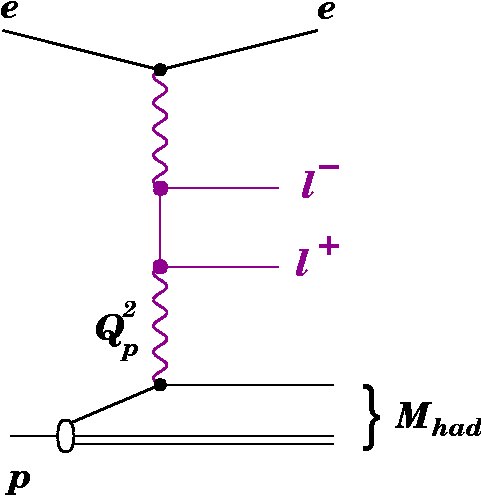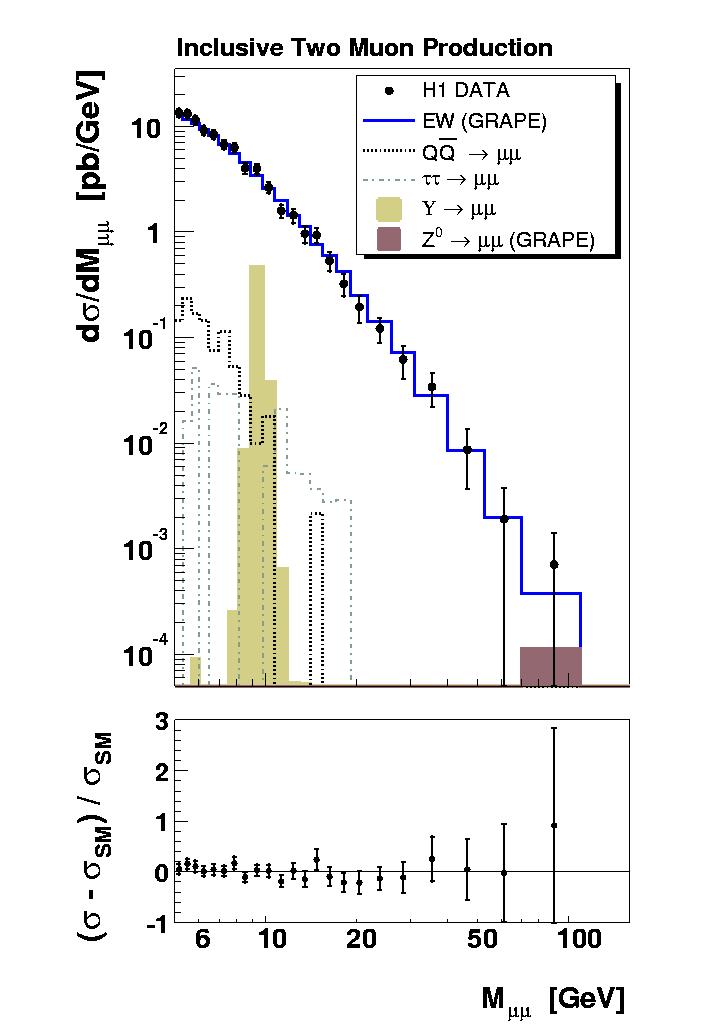back to overview of this paper
Muon Pair Production in ep Collisions at HERA
|
 Muons are elementary particles, very similar to electrons, but with a
mass which is 200 times larger. In contrast to electrons, their large
mass allows them to penetrate great distances
through matter. Muons with an energy greater than a few GeV thus tend to
escape from particle physics detectors, but they leave tracks behind them which
provide a clear signature. Muons therefore offer a unique testing ground for
rare and exotic processes, provided that the standard model backgrounds
are well understood. In electron proton
scattering, muon pairs are mainly produced in two-photon interactions, where
the incoming photons are radiated from the beam particles. The Feynman
diagram for this dominant production mechanism is shown on the right.
The cross section becomes large when the momentum transfer
to the scattering particles is small and the photons are quasi-real. Since
the photon-photon interaction and the photon coupling to the electron are
governed by electroweak interactions, they can be precisely calculated using
the Standard Model of particle physics. The only large uncertainty in the
calculation arises from the photon flux associated with the proton.
Muons are elementary particles, very similar to electrons, but with a
mass which is 200 times larger. In contrast to electrons, their large
mass allows them to penetrate great distances
through matter. Muons with an energy greater than a few GeV thus tend to
escape from particle physics detectors, but they leave tracks behind them which
provide a clear signature. Muons therefore offer a unique testing ground for
rare and exotic processes, provided that the standard model backgrounds
are well understood. In electron proton
scattering, muon pairs are mainly produced in two-photon interactions, where
the incoming photons are radiated from the beam particles. The Feynman
diagram for this dominant production mechanism is shown on the right.
The cross section becomes large when the momentum transfer
to the scattering particles is small and the photons are quasi-real. Since
the photon-photon interaction and the photon coupling to the electron are
governed by electroweak interactions, they can be precisely calculated using
the Standard Model of particle physics. The only large uncertainty in the
calculation arises from the photon flux associated with the proton.
 The data collected by the H1 collaboration at an electron proton centre of
mass energy of 319 GeV have been used to extract cross sections
for muon pair production, in order to test our understanding of the
production mechanisms and search for new physics beyond the Standard Model.
Differential cross sections have been measured for the production of muon
pairs (ep -> e mu mu X)
as a function of the di-muon invariant mass, the transverse momenta of
the muons and the transverse momentum of the hadronic recoil, X. On the
basis of the level of observed hadronic activity, the cross
sections have also been separated into an elastic component, where the proton
remains intact, and an inelastic component, in which the proton dissociates
to form a higher mass system X.
All measured cross sections were found to be in good agreement with the
Standard Model predictions. As an example, the figure on the left shows the
cross section as a function of the di-muon mass. The data
agree well with the electroweak prediction (EW GRAPE), which contains the
dominant two-photon process together with other smaller contributions
from Bremsstrahlung processes in which radiated photons convert to muon
pairs and contributions in which heavy Z0 bosons replace the
photons.
The predictions for other contributions to two muon production, due to
Upsilon production, heavy flavour and tau lepton decays are also shown.
These contributions are small and are only present at low di-muon masses.
The data collected by the H1 collaboration at an electron proton centre of
mass energy of 319 GeV have been used to extract cross sections
for muon pair production, in order to test our understanding of the
production mechanisms and search for new physics beyond the Standard Model.
Differential cross sections have been measured for the production of muon
pairs (ep -> e mu mu X)
as a function of the di-muon invariant mass, the transverse momenta of
the muons and the transverse momentum of the hadronic recoil, X. On the
basis of the level of observed hadronic activity, the cross
sections have also been separated into an elastic component, where the proton
remains intact, and an inelastic component, in which the proton dissociates
to form a higher mass system X.
All measured cross sections were found to be in good agreement with the
Standard Model predictions. As an example, the figure on the left shows the
cross section as a function of the di-muon mass. The data
agree well with the electroweak prediction (EW GRAPE), which contains the
dominant two-photon process together with other smaller contributions
from Bremsstrahlung processes in which radiated photons convert to muon
pairs and contributions in which heavy Z0 bosons replace the
photons.
The predictions for other contributions to two muon production, due to
Upsilon production, heavy flavour and tau lepton decays are also shown.
These contributions are small and are only present at low di-muon masses.
In another recent H1 paper
( DESY-03-082 ), the closely related topic of
multi-electron production was studied.
Excesses over the Standard Model
predictions were observed in the numbers of events containing two electrons
and three electrons for which the invariant mass M12
of the two electrons
with the largest transverse momentum was larger than 100 GeV.
The well established principle of lepton universality implies that any
such anomaly in multi-electron production is likely to be visible also
in muonic final states. It is therefore worthwhile to analyse the muon pair
data in a similar way as is done in the multi-electron
analysis. In order to optimise the
statistics for this part of the analysis, the full HERA-I data, including
early data at an ep centre of mass energy of 301 GeV, are included.
Final states containing two muons
(mu-mu) or two muons and an electron (mu-mu-e) are studied.
For masses M12 > 100 GeV, one mu-mu event is found,
while 0.08 ± 0.01 are expected from the Standard Model predictions. No event
classified as mu-mu-e with M12 > 100 GeV is
observed. The prediction is 0.05 ± 0.01. With such small event numbers,
a comparison of the findings in the electron and muon channels is
inconclusive. We therefore look forward eagerly to the large
increases in statistics expected in the second phase of
HERA operation.
 Muons are elementary particles, very similar to electrons, but with a
mass which is 200 times larger. In contrast to electrons, their large
mass allows them to penetrate great distances
through matter. Muons with an energy greater than a few GeV thus tend to
escape from particle physics detectors, but they leave tracks behind them which
provide a clear signature. Muons therefore offer a unique testing ground for
rare and exotic processes, provided that the standard model backgrounds
are well understood. In electron proton
scattering, muon pairs are mainly produced in two-photon interactions, where
the incoming photons are radiated from the beam particles. The Feynman
diagram for this dominant production mechanism is shown on the right.
The cross section becomes large when the momentum transfer
to the scattering particles is small and the photons are quasi-real. Since
the photon-photon interaction and the photon coupling to the electron are
governed by electroweak interactions, they can be precisely calculated using
the Standard Model of particle physics. The only large uncertainty in the
calculation arises from the photon flux associated with the proton.
Muons are elementary particles, very similar to electrons, but with a
mass which is 200 times larger. In contrast to electrons, their large
mass allows them to penetrate great distances
through matter. Muons with an energy greater than a few GeV thus tend to
escape from particle physics detectors, but they leave tracks behind them which
provide a clear signature. Muons therefore offer a unique testing ground for
rare and exotic processes, provided that the standard model backgrounds
are well understood. In electron proton
scattering, muon pairs are mainly produced in two-photon interactions, where
the incoming photons are radiated from the beam particles. The Feynman
diagram for this dominant production mechanism is shown on the right.
The cross section becomes large when the momentum transfer
to the scattering particles is small and the photons are quasi-real. Since
the photon-photon interaction and the photon coupling to the electron are
governed by electroweak interactions, they can be precisely calculated using
the Standard Model of particle physics. The only large uncertainty in the
calculation arises from the photon flux associated with the proton.
 The data collected by the H1 collaboration at an electron proton centre of
mass energy of 319 GeV have been used to extract cross sections
for muon pair production, in order to test our understanding of the
production mechanisms and search for new physics beyond the Standard Model.
Differential cross sections have been measured for the production of muon
pairs (ep -> e mu mu X)
as a function of the di-muon invariant mass, the transverse momenta of
the muons and the transverse momentum of the hadronic recoil, X. On the
basis of the level of observed hadronic activity, the cross
sections have also been separated into an elastic component, where the proton
remains intact, and an inelastic component, in which the proton dissociates
to form a higher mass system X.
All measured cross sections were found to be in good agreement with the
Standard Model predictions. As an example, the figure on the left shows the
cross section as a function of the di-muon mass. The data
agree well with the electroweak prediction (EW GRAPE), which contains the
dominant two-photon process together with other smaller contributions
from Bremsstrahlung processes in which radiated photons convert to muon
pairs and contributions in which heavy Z0 bosons replace the
photons.
The predictions for other contributions to two muon production, due to
Upsilon production, heavy flavour and tau lepton decays are also shown.
These contributions are small and are only present at low di-muon masses.
The data collected by the H1 collaboration at an electron proton centre of
mass energy of 319 GeV have been used to extract cross sections
for muon pair production, in order to test our understanding of the
production mechanisms and search for new physics beyond the Standard Model.
Differential cross sections have been measured for the production of muon
pairs (ep -> e mu mu X)
as a function of the di-muon invariant mass, the transverse momenta of
the muons and the transverse momentum of the hadronic recoil, X. On the
basis of the level of observed hadronic activity, the cross
sections have also been separated into an elastic component, where the proton
remains intact, and an inelastic component, in which the proton dissociates
to form a higher mass system X.
All measured cross sections were found to be in good agreement with the
Standard Model predictions. As an example, the figure on the left shows the
cross section as a function of the di-muon mass. The data
agree well with the electroweak prediction (EW GRAPE), which contains the
dominant two-photon process together with other smaller contributions
from Bremsstrahlung processes in which radiated photons convert to muon
pairs and contributions in which heavy Z0 bosons replace the
photons.
The predictions for other contributions to two muon production, due to
Upsilon production, heavy flavour and tau lepton decays are also shown.
These contributions are small and are only present at low di-muon masses.